
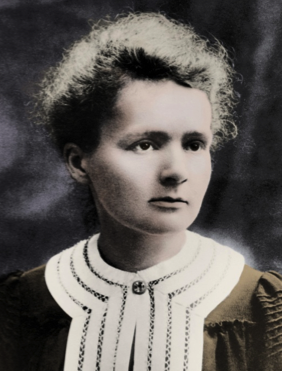 Marie Sklodowska Curie Photo: ACJC
Marie Sklodowska Curie Photo: ACJC
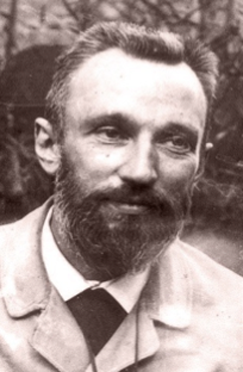 Pierre Curie Photo: ACJC
Pierre Curie Photo: ACJC
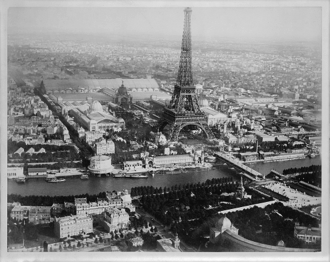 The new Eiffel Tower epitomized Paris’ status as the world’s most sophisticated city in the 1890s.
The new Eiffel Tower epitomized Paris’ status as the world’s most sophisticated city in the 1890s.
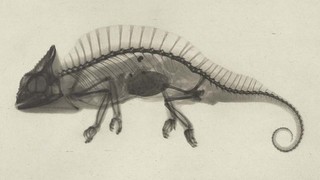 While her colleagues rushed to study newly discovered X-rays, Marie turned her attention to a different kind of ray.
While her colleagues rushed to study newly discovered X-rays, Marie turned her attention to a different kind of ray.
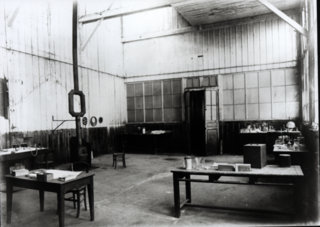 To isolate radium, Marie Curie spent four years working in a shed once used as a dissecting room but no longer considered fit even for the dead bodies.
To isolate radium, Marie Curie spent four years working in a shed once used as a dissecting room but no longer considered fit even for the dead bodies.Photo: ACJC
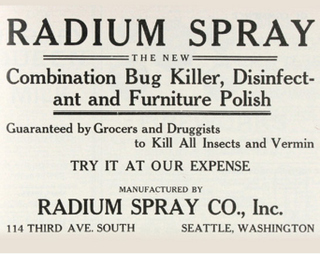 One of the many dubious radium products
One of the many dubious radium products
Polish Origins
She was the unlikeliest of revolutionaries: a 30-year-old graduate student … a woman at a time when they were essentially unheard of in physics and chemistry … from Poland, a country hardly known for its leadership in science. Yet in four short years, Marie Curie’s discoveries would transform our understanding of matter and make her one of the most famous women in the world.
She was born Maria Sklodowksa in 1867, at a time when Warsaw had been swallowed by Russia and Poland literally wiped off the map. The daughter of two teachers, Maria excelled in science and math. But in Russian-ruled Poland, women were not allowed to attend university, let alone become scientists. Her only hope was to go to Paris. But because her family could not afford to send her, Maria would first have to work for six long years as a governess to support her older sister’s studies. Only at age 24 did she finally get her chance. “She waited her turn, and she didn’t give up,” says biographer Susan Quinn. “And when the turn came, she took it.”
Paris and Pierre
In Paris, Maria reveled in the freedom and technological sophistication of the most modern city in the world. At the Sorbonne, she graduated first in her class in physics, and soon after graduation she met a physicist named Pierre Curie. They married in 1895 and immediately began a family. But in 1897, even with a young daughter to care for, Marie set her sights on earning something no other woman in France had ever received: a doctorate in physics.
Discovering Radioactivity
While scientists all around her were investigating the latest exciting discovery – X-rays – Marie focused her dissertation on a different kind of ray given off by the element uranium. These “uranic rays,” discovered by French physicist Henri Becquerel just a year earlier, had the strange power to “ionize” the air around them, making it a better conductor of electricity. Marie was in a unique position to investigate these rays, because Pierre was a world expert on ways to measure minute electrical currents. Using instruments Pierre had invented, Marie began what she expected to be a workmanlike study of this new phenomenon. But she soon discovered that the element thorium also gave off these rays. Since it was no longer appropriate to call them “uranic rays,” Marie proposed a new name: “radioactivity.”
New elements
Even more surprising, Marie next found that a uranium ore called pitchblende contained two powerfully radioactive new elements: polonium, which she named for her native Poland, and radium. To convince skeptical chemists that radium was real, Marie spent four years isolating one tenth of a gram of radium chloride from ten tons of pitchblende. In the process she discovered that radium glowed in the dark, pouring out heat and light, seemingly forever.
What’s inside the atom?
In time, other scientists would explain this mysterious phenomenon: The energy came from radium atoms breaking down, spitting out pieces of themselves and turning into different elements. Marie Curie had overturned two of the bedrock principles of chemistry: that atoms are the smallest units of matter, and that one element cannot turn into another.
If radioactivity was atoms falling apart, then atoms must have parts. Thanks to this Polish expatriate … this graduate student … this young mother … scientists had a pressing new question to answer: What’s inside the atom? That question would occupy scientists around the world for the next 30 years and beyond.
The Radium Craze
Radium’s wondrous ability to glow in the dark wasn’t only of interest to scientists. It also inspired a worldwide craze – a rush of radium-laced products that promised to cure everything from impotence to hair loss. What few people realized was that most of these products were not only ineffective but dangerous. Just how dangerous only became clear when the “Radium Girls” – women hired to apply radium-laced paint to watches and dials – began dying horribly. Marie and Pierre Curie were among the first to see evidence of the potential harmful effects of radiation. And yet, perhaps reluctant to admit the negative effects of the magical element they had discovered, and hoping its power could be harnessed to cure cancer, they were slow to acknowledge the harm radiation could do, even to themselves. For more on this fascinating chapter, watch The Radium Craze.
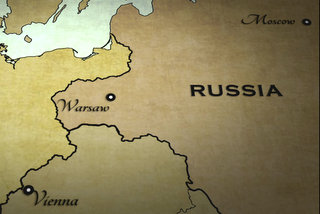 During Maria Sklodowska’s youth, Warsaw was part of Russia, and Poland had been wiped from the map.
During Maria Sklodowska’s youth, Warsaw was part of Russia, and Poland had been wiped from the map.
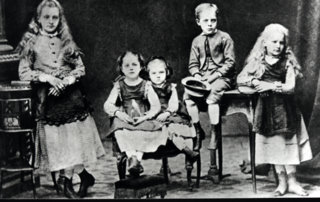 Maria (center) was the youngest of the five Sklodowski children. Photo: ACJC
Maria (center) was the youngest of the five Sklodowski children. Photo: ACJC
Film Clip: Discovering Radioactivity - Marie soon discovers that the element thorium also has the power to ionize the air – a property she calls “radioactivity” – and that the uranium ore pitchblende must contain at least one more radioactive element. Film Clip: New Elements - Marie’s studies show that pitchblende contains two new radioactive elements – polonium, named for her native country, and radium. Film Clip: What's Inside the Atom? - The discovery that radioactivity is atoms falling apart shows that atoms are not the smallest units of matter, after all, and raises a pressing new question for scientists: What’s inside the atom? Video: The Radium Craze - Radium’s magical ability to glow in the dark inspires a rush of radium-laced products that promise to cure ailments of all sorts but which ultimately do more harm than good.
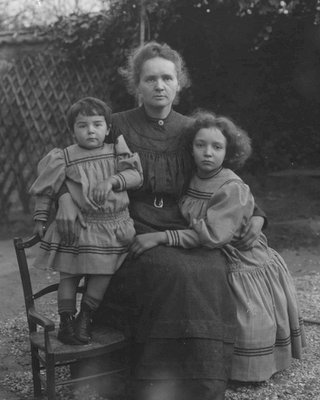 Marie juggled the responsibilities of pursuing a career in science and raising her two daughters, Irene and Eve – even after Pierre’s death in a 1906 traffic accident.
Marie juggled the responsibilities of pursuing a career in science and raising her two daughters, Irene and Eve – even after Pierre’s death in a 1906 traffic accident.Photo: ACJC
Woman in a Man’s World
To pursue a career in science, Marie Curie had to overcome a gauntlet of obstacles. Unable to attend university in Russian-ruled Poland, she worked for six years as a governess before getting a chance to study in Paris. She was one of only a handful of female science students at the Sorbonne ... but graduated first in her class in physics. Her first paper on radioactivity was largely ignored, because it came from a mere graduate student, a foreigner, and a woman married to a teacher in an industrial school. When it came time to recognize the important discovery of radioactivity, a group of Frenchmen made no mention of her in their Nobel Prize nomination letter; only Pierre’s adamant intercession won her a share of the prize. And even after winning a second Nobel Prize all her own, she could still not win acceptance to the prestigious Royal Academy of Sciences. Yet Curie carried on in the face of all these obstacles to leave her mark on history. For more on Curie’s remarkable tenacity – and the inspiration she provides to other female scientists – watch Woman in a Man’s World.
Video: Woman in a Man’s World - Marie Curie’s remarkable tenacity in the face of the obstacles in her path has inspired countless women pursuing their own careers in science.
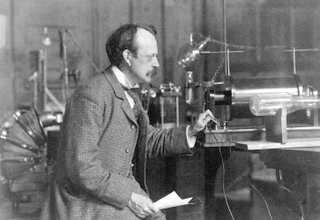 Physicist J.J. Thomson of England's Cambridge University discovered the first of the atom’s pieces in 1897: the tiny, negatively charged electron.
Physicist J.J. Thomson of England's Cambridge University discovered the first of the atom’s pieces in 1897: the tiny, negatively charged electron.
Into the Atom
Radioactivity was the first of a series of discoveries, beginning in the late 1890s, that led to a radically new view of the atom. Until then, most scientists believed atoms were the smallest units of matter and that it was impossible for one kind of atom, or element, to turn into another. But the Curies’ research opened a new window on the atom, revealing that there must be smaller pieces inside, still awaiting discovery. Over a period of 35 years, scientists across Europe discovered those pieces and learned how they fit together: the electron, the nucleus, the proton and finally the neutron. In making these discoveries, these scientists not only abolished the old idea that atoms were unsplittable; they also showed that changes to an atom’s internal parts could change its very identity. For more on the Curies’ role in starting this revolution, watch Into the Atom, Part 1: Atoms Have Parts.
Want to Learn More?
To see the full Marie Curie story, select Watch Online to go to pbs.org/mysteryofmatter and view Episode 2. Or click on Buy to purchase the series DVD at ShopPBS. And for more resources about Marie Curie’s amazing life and career, select Learn More.